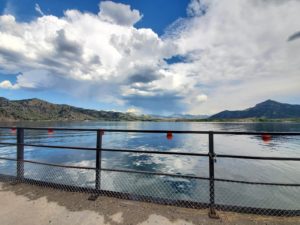
We ambled through the fluorescent green tint of the dim concrete hallway. Further down, it was dark. Small streams of leaking water trickled down the tight, rough walls, making the air musty and cool. Small stalactites dangled from the ceiling through the cracks, an unstoppable buildup of calcium over the course of the last 103 years. I felt the walls closing in. We were standing in the basement of the Holter Dam on the Missouri River near Wolf Creek, Montana.
It was Day 16 of the WRFI Cycle the Rockies course, halfway through. To celebrate, we rounded out our unit focusing on the consumption and conservation of energy. The tour of the Holter Dam seemed a perfect way to understand this aspect of the course, as hydro is among the oldest forms of produced energy. This dam was constructed in 1917, making many of its parts over 100 years old. The abundant falling water and the quickly spinning turbines serve a significant role in lighting up the grid.
Early that morning, we rode down a long dirt road into a canyon, where we flew down hills next to a glistening creek. The cool breeze across the water made our ride that day absolutely blissful. We stopped to put our feet in the creek to cool off once the temperatures rose. We fell behind schedule and the cool of the early morning start gave way to the heat dome smothering the Pacific Northwest. We arrived at the dam sweaty and woozy.
Our tour guide, Cody Gatch, is a supervisor at the dam. He greeted us with a smile warmer than the day. The dam has four turbines that generate a maximum 48 megawatt hours. It gets its highest flow rate during the wettest months of May and June, typically the wetter season. The unusually dry spring and early summer Montana has experienced this year, and in recent years past, has meant it usually runs well below its potential.
The 103-year old dam works the way it always has. Falling water turns massive turbines to produce electricity. Our visit coincided with a full replacement of one of the turbines. The massive steel parts lay, disassembled, on the powerhouse floor. For only the second time in the dam’s history, all four turbines were being replaced. One at a time. Dams have been a consistent source of energy for many years, making them a well understood form of low-carbon emissions energy.
The impact the Holter Dam has had on the nearby ecosystem in the last century has been significant. The dam’s geography puts it at the north end of three lakes, turning what was once a flowing river into a chain of reservoirs. This certainly had an effect on trout populations in the system, whose instinct is to travel upriver for their spawning grounds. The dam blocks that journey. It turned a river into a lake.
The series of dams puts the area in a unique situation, where it is nearly impossible to revert the system back to its original state. It’s also important to recall that this type of energy source (once it is up on its feet and running) is carbon-neutral. Some people believe dams are an essential part of a fossil free power grid and many more are needed.
Reporter Eric Holthaus said there are an estimated 3700 new dams in the works worldwide. He also cautioned that thousands of dams are less effective than they used to be. A world with less water may make dams like Holter less reliable than they have been.
Back in the heat, we faced a long trip down stream to cross a bridge to get to our campground. Knowing we were exhausted, Cody allowed us to bike across the top of the dam. Going over as a group, we saw the Rocky Mountains rising above the water in the distance. The dam acted as our bridge to the finish line, just as hydro energy may serve as a bridge to a bright future in renewable energy. In the race against irreversible climate change, hydropower dams may be part of the future. It is up to the public to determine if they are built in ways that are environmentally sound and socially just.
Leila Gabrys is a college junior attending the University of Wisconsin Madison for meteorology and environmental studies.